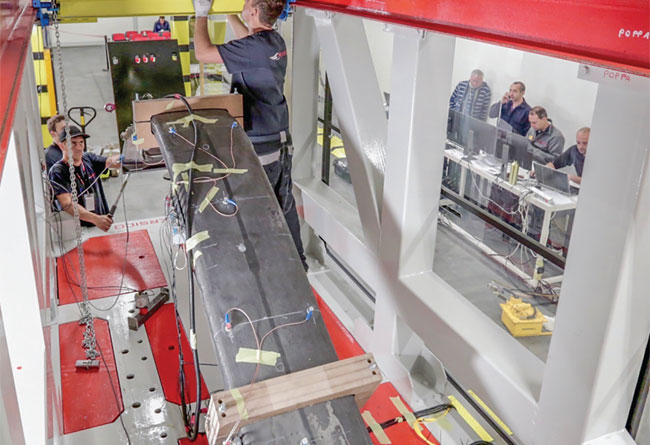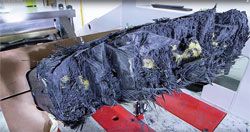

Customers of QI Composites have fared better than most when it comes to avoiding unwanted surprises
As the quest for more and more extreme performance in sailboat racing continues, designers and builders face ever increasing challenges. While advanced composite construction is taken to the limits, the need for in-depth, expert quality testing of build parts – hulls, decks, appendages, rigs – plays an increasingly crucial role.
Over the last 20 years, QI Composites has become the globally accepted expert for NDT (nondestructive testing) and evaluation of technical build specifications and their practical execution. ‘We have been involved in all America’s Cups since 2001, in 2007 working for nine teams; also in all Volvo Ocean Races since 2007, official NDT supplier for entire V65 fleet for past two editions and Ferrari F1 consultant since 2012. We have also partly or entirely checked the majority of composite superyachts made in the last 15 years,’ says Stefano Beltrando, CEO. QI Composites’ clients include renowned builders who use the firm to validate their work and for R&D activity, yacht owners seeking to protect their investment, racing teams as in the America's Cup and insurance companies who use QI for damage assessment.
Keeping pace with the leading edge in design and construction is critical and at QI Composites, the criteria to evaluate defects or to define the testing procedure are updated frequently and at least once a year. In fact, the testing is so refined that they can detect any defect, even a microscopic one. ‘But then the acceptability is wider by several orders of magnitude. That is, the client asks you to detect defects that are tenths of a millimeter wide, but then they accept defects that are 1000 times wider. Therefore, the investigation tool should be proportionate to the answers. To read a book, one puts on only glasses, if needed; no one would use a microscope’, Beltrando explains.
Custom - or nearly custom - products such as yachts cannot afford the cost of ‘crash tests’ because it would be exorbitant and unacceptable. So – except in some very rare cases as the America’s Cup one-design arms or the Volvo 65 daggerboards – 1:1 scale destructive tests are replaced by sample tests, certification of materials and projects, and possible inspections at the shipyard by the competent bodies. For the final evaluations, a high degree of experience is needed. A destructive test is fairly straightforward: the builder manufactures a copy of the desired component. This is fitted with internal fibre optic sensors and, after placing it into a test bench, it is deformed to breaking point. At QI Composites, the non-destructive test is made by checking the components beforehand to make sure a good copy is used for the bend test, then monitoring the component during the test in order to spot any degradation and finally making a ‘post mortem’ inspection to investigate the start and propagation of the final failure.
The work of QI Composites also needs to be verified by an external and authoritative opinion. This is the aim of the certification body DNV-GL (Den Norske Veritas – Germanischer Lloyd), which, since 2013, approves not only QI’s laboratory but also their inspection procedures for composite yachts, masts, and other composite components. This means that inspection methods, inspection coverage, personnel training and data management are approved by a world-class institution, stating that what comes from QI’s 20-year experience officially and technically actually makes sense.

What are the most common problems in composite structures for yachts today? Beltrando has the answer: ‘in racing yachts: core failures. In superyachts: plans mismatch (real boat is different from design). In medium-sized rigs: voids. And in large rigs: reinforcement de-bonds.’
And how big can the biggest defect admissible in a structure be – is that to be defined by the designer? ‘In the ideal world, this should be defined by the designer since he knows the loads, the materials and aim of the structure,’ Beltrando says. ‘In reality there's a distance between what the owner wants, what the designer designs and what the builder builds. So, our role is to take the dreams to the tech specs and so to the real world. In the end the acceptance criteria are a mix of the wishes of these three players. Before construction, we're often interviewed by the design teams for two main reasons: in the design, laminate specs and materials, do you see any weak spot based on your failure database? And the other one is: can you help lawyers, designers, builders and owners to agree on a feasible, technical build specification?’
Due to their unique and recognised technical experience, QI Composites can.
Click here for more information on QI Composites »
We invite you to read on and find out for yourself why Seahorse is the most highly-rated source in the world for anyone who is serious about their racing.
To read on simply SIGN up NOW
Take advantage of our very best subscription offer or order a single copy of this issue of Seahorse.
Online at:
www.seahorse.co.uk/shop and use the code TECH20
Or for iPad simply download the Seahorse App at the iTunes store


